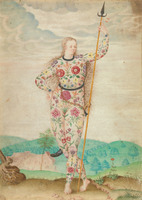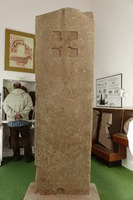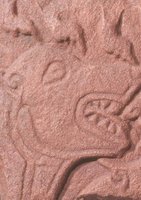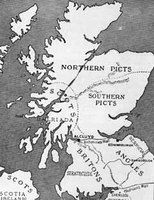Language
  | The Picts spoke a Brittonic language, similar to Welsh or Cornish. In the first millennium BC, the common root of the native languages spoken across the British Isles was Celtic. But these languages evolved with time. In Ireland and the far west of Scotland, Celtic developed into Gaelic. Linguists refer to the various strands of this language as Q-Celtic. In other regions, P-Celtic (or Brittonic) languages developed, including Pictish. Pictish gradually died out during the 10th and 11th centuries, and Gaelic became the everyday language of former Pictish regions. |
Housing
 | Pictish buildings would appear to have varied depending on regional location and building material available. Evidence of Pictish housing finds them to be of a reasonable size, round or oval shaped with no windows and a central hearth. Access to these buildings would be through a low and narrow doorway. |
Painted Skin
 | It is said that the Picts got their name from the Romans, who called them Picti, which is Latin for ‘painted people’. This is thought to refer to the tales of the Picts painting and tattooing their bodies. |
Rosemarkie Cross Slab
 | The original location of the Rosemarkie Cross Slab was most likely within a Pictish settlement or monastery, it later was used as a floor slab in Rosemarkie Church and also stood in the Churchyard, before being moved and preserved within Groam House Museum. |
Folklore
 | David MacRitchie, a Scottish folklorist (1851-1925), argued that fairies were based on a real diminutive or pygmy-statured population that lived in Scotland during the late Stone Age: "Postulations based on the premise that fairies constitute a folk memory of former races, conquered peoples who were pushed out beyond the periphery of settled areas, have fuelled the imagination of many scholars on this subject. Of particular significance was a theory advanced by David MacRitchie that fairies were an actual race of small or 'little' people, the original Pictish peoples of Scotland." |
Food and Crops
 | Archaeological excavations have shown that Pictish settlements contained sheep, cattle and pigs. They also grew crops such as barley and oats. Depictions in the stone carvings show scenes of hunting wild animals and fishing. |
Work
 | The Picts would have travelled by land and sea. As well as being skilled stone masons the Pictish people would have had to work together building housing, growing crops, tending livestock, hunting, weaving, making tools and clothing, carving boats and canoes. |

The Picts or Pictish people are commonly associated with the tribal confederation of peoples who lived in what is today eastern and northern Scotland during the Late Iron Age and Early Medieval periods.
We know very little about the Picts. Some information about where they lived and what their culture was like can be inferred from the geographical distribution of their settlements, the place names carrying Pictish elements (names with "pit" or "pett", for example), and the distribution and style of Pictish stones.
Picts are referred to in written records from before the Roman conquest of Britain to the 10th century, when they are thought to have merged with the Gaels. They lived to the north of the rivers Forth and Clyde, and spoke the now-extinct Pictish language which is thought to have been related to the Brittonic language spoken by the Britons who lived to the south of them.
Picts are thought to have been the descendants of the Caledonii and other tribes that were mentioned by Roman historians or on the world map of Ptolemy. Pictland, also called Pictavia, gradually merged with the Gaelic kingdom of Dál Riata to form the Kingdom of Alba (Scotland). Alba then expanded, absorbing the Brittonic kingdom of Strathclyde and Bernician Lothian, and by the 11th century the Pictish identity had been subsumed into the "Scots" amalgamation of peoples.
Pictish society was typical of many Iron Age societies in northern Europe, having "wide connections and parallels" with neighbouring groups.
The Picts spoke a Brittonic language, similar to Welsh or Cornish.
In the first millennium BC, the common root of the native languages spoken across the British Isles was Celtic. But these languages evolved with time. In Ireland and the far west of Scotland, Celtic developed into Gaelic. Linguists refer to the various strands of this language as Q-Celtic. In other regions, P-Celtic (or Brittonic) languages developed, including Pictish.
Pictish gradually died out during the 10th and 11th centuries, and Gaelic became the everyday language of former Pictish regions.